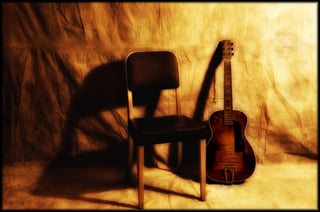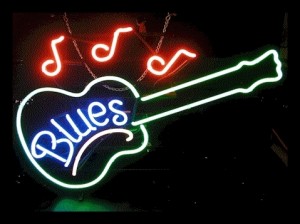There are many winding ways to proficiency on the guitar, I mean besides the obvious rout of formal instruction and years of practice. I advocate for listening to as many different kinds of music as possible and have written about active listening, exploring your influences influences and just really digging deep into the music that flips your switch. Searching for and making connections between seemingly disparate artists and bands can lead to illuminating discoveries. A holistic approach to music appreciation is rewarding in and of itself and will pay dividends down the road as your skills progress. However, if I had to think back upon one point in my life where I made the most progress in the shortest amount of time it had to be that sophomore year in H.S. when I started jamming the blues.
The Blues like any musical genre can be divided into subsets that reflect region, era, instrumentation, etc. You may not like the Blues and have no use for it but here’s where I make my case for the Blues as a way to become a better guitar player. A characteristic of the Blues that the genre’s detractors cite when they explain why they don’t like it: “it all sounds the same”, “it’s repetitious”, and “it’s just the same chords over and over again” is what works for beginners. When I was just learning how to play nice with others, the form, structure and cyclical nature of the Blues was exactly what I needed! If that transition from one chord to the next wasn’t smooth or I missed it altogether guess what? My chance to get it right the next time is gonna come right around again! There were the new chords I was learning as I went and I was using scales contextually in addition to just playing them chromatically by myself up and down the neck to a metronome. Importantly, there was the experience of listening to someone else while playing-an essential skill for “Phase III” players, the final stage of a totally un-scientific measure of ability I came up with and described in a previous blog.

By getting the basic Blues down I was able to hang and jam with players that were light-years ahead of me and just soak up all that next-level riffage. This is how I first started to develop improvisational skills- taking turns soloing with a friend or two. Jamming the Blues offered the opportunity to experience the camaraderie and fellowship of playing with other musicians within an agreed upon and predictable format. I’ve heard if you want to get better at golf, play with people whom are better than you. Well guess what? Jamming the Blues can provide that opportunity in a way nothing else can. It’s the universal language of guitar players, a lingua franca that can help form an instant bond with you and others from all over the world. Imagine: three different guitar players, three different languages, complete strangers, all jamming the Blues in E. Consider this suggestion as a stage of development in your playing, it’s- a win-win situation, even if you’re not a fan.
So, there’s my case for the Blues as a developmental step and approach to learning and becoming a better guitar player. However I would be remiss if I failed to share my personal appreciation of the genre as representative of a distinctively American mode of expression. Books have been and will continue to be written about the impact of the Blues on all popular music and its role as the progenitor of Rock n’ Roll. One facet of my appreciation of music, especially the Blues, is based on an interest in History, the Social Sciences and how music is an expression of culture and experience.

In my lifetime the popularity and resurgence of the Blues is often traced to Stevie Ray Vaughan and his career. His steadfastness and perseverance at a time when the Blues wasn’t on anyone’s radar (consider the famous snub of SRV and Double Trouble at the Montreux Jazz Festival in 1982) and his eventual success set the stage for the popular acceptance of Blues. Artists who had long been in the game but maybe had little crossover appeal or even waning careers were able ride the wave SRV almost single-handedly created. This is a subject of study for music historians and one could write at length about those Bluesmen who walked through the door SRV opened. For me, my first awareness of the Blues goes back a little farther than the relatively short late ‘80’s, early ‘90’s success and tragic end of Vaughn’s career. It was from a movie and the accompanying soundtrack my mother bought me which was a passion project of a couple of comedians and musicians from my NYC home when I was 10 years old in 1980. That’s right, I’m talking about Dan Aykroyd and John Belushi and the seasoned musicians that helped create The Blues Brothers.
It was in interviews with Canadian-born Aykroyd that I learned of his deliberate effort to preserve and share an American cultural legacy he so admired and respected. The debut of Saturday Night Live coincided with the rise and early successes of some great N.Y.C-based bands. Many know of the legendary music scene in the mid-to-late ‘70’s that SNL helped bring to national attention by showcasing those musical guests but by the end of the decade it was Disco music that was sweeping the nation. Prior to the production of the film, The Blues Brothers, comprised of Aykroyd, Belushi and the SNL band under the direction of Paul Schaffer toured as the opening act for the hugely popular comedian and SNL staple Steve Martin. The live album Suitcase Full of Blues is a record of that tour and it’s evident that the production was a passion project for those involved, an opportunity to earn for veteran players like Donald “Duck” Dunn, Matt “Guitar” Murphy and the other musicians some of which had cameos in the subsequent film.

I’m indebted to this effort because, well because Disco, but also because it was my first exposure to John Lee Hooker, Arethra Franklin and many of the other legendary artists who performed in the movie including Sam and Dave, who were not featured in the original soundtrack but whose music was playing on the 8-track in the Bluesmoblie when Jake and Elwood blew through that red light in suburban Illinois (“It was yellow sir.”). My mother encouraged my love of music by buying me the soundtracks of the movies I loved. Needless to say I was a John Williams fan and his film scores to Spielberg and Star Wars movies encouraged an appreciation of Classical music down the line but The Blues Brothers soundtrack was unlike any other I had. In a very real sense Dan Aykroyd succeeded in his desire to preserve and pass on his love of this very American art form to a new generation. At least he did for this kid.
Finally, there’s the shared emotional experience that we can relate to as thinking, feeling human beings that the Blues specifically springs from. You may think you know the Blues and there’s no doubt that you’ve had the blues at some point. As varied as the Blues is as a genre it does reflect the myriad ways of feeling blue, a mirror of our shared human experience and perhaps it’s why it continues to be relevant today. Ironically, it’s the expression of the powerful emotions of sadness, despair and loss via the Blues that can uplift us, bring us together and help get through the hard times; the healing power of music from a distinctly American experience that continues to resonate from our past.
Let us know if you liked this blog:


